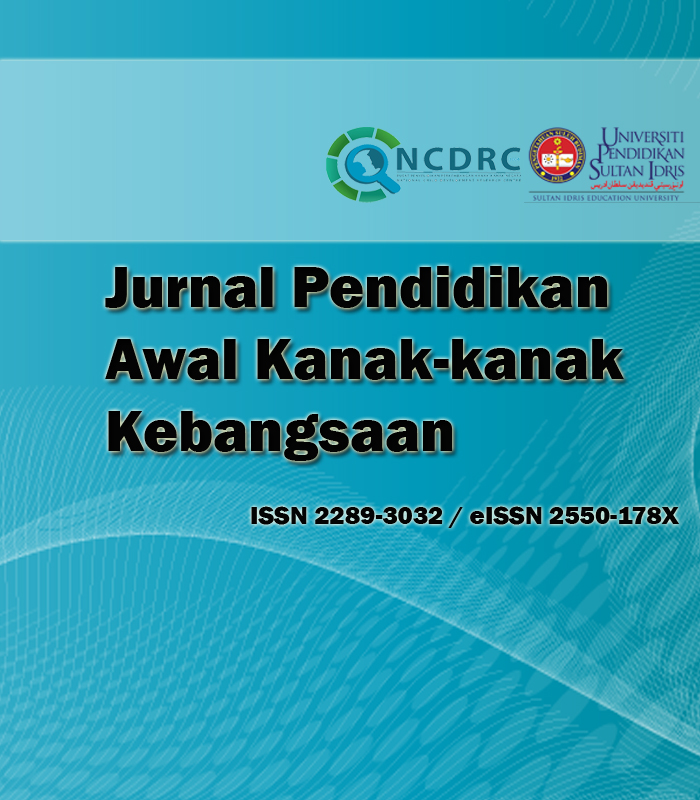Sustainability of Quality Education: Development of a Pattern Learning Module for Early Mathematics Based on Flipped Classroom with Augmented Reality
Kelestarian Pendidikan Berkualiti: Pembangunan Modul Pembelajaran Pola berasaskan Pembelajaran Berbalik dengan Penggunaan Realiti Terimbuh
DOI:
https://doi.org/10.37134/jpak.vol11.1.8.2022Keywords:
Flipped classroom, augmented reality, Fuzzy Delphi Technique, pattern, dimensionAbstract
Quality education is one of the important agendas in the Sustainable Development Goals (SDGs). The fourth goal under quality education states that by 2030, all students will have quality early childhood education at the preschool level and be ready to enter education at the primary school level. The methods of teaching and learning for students are now changing in line with the endemic situation that is taking place around the world. However, continuous efforts need to be implemented, especially in terms of methods and the use of teaching materials. In this study, the development of a module that integrates augmented reality technology with the concept of reverse learning through pattern titles is an effort to reduce the gap in student mastery in the subject of Early Mathematics and stimulate student creativity. The study involved 120 respondents consisting of teachers and parents as well as 25 students from TADIKA around Petaling Jaya. The study methodology combines five stages of the ADDIE Model along with three phases of the Developmental Design Research Approach (DDR) involving the Fuzzy Delphi Technique with the consensus of 10 field experts and the Bednarik TUP Consumer Assessment Model. Overall, it was found that there is a gap in the mastery of students and teachers need more interactive modules. Pupils ’creativity is still at a low level and there are constraints of parental support at home.
Downloads
References
Dina Julita, Rudi Susilana (2018). Implementasi Kurikulum Montessori Bernafaskan Islam Pada Pendidikan Anak Usia Dini Rumah Bermain Padi Di Kota Bandung. Pusat Pengembangan PAUD & Pendidikan Masyarakat Jawa Barat dan Universitas Pendidikan Indonesia.
Dina Tirosh, Pessia Tsamir, Ruthi Barkai, Esther Levenson (2017). Preschool Teachers’ Variations When Implementing A Patterning Task. CERME 10, Feb 2017, Dublin, Ireland. ffhal-01938920.
Doig, B. & Ompok, C. (2010). Assessing Child Informal Mathematic Abilities Through Games. Mathematics In Early Childhood. Procedia-Social and Behavioral Sciences, 8, 228-235.
Donna Kotsopoulos, Lisa Floyd, Vivian Nelson and Samantha Makosz (2019). Mathematical or Computational Thinking? An Early Years Perspective (n.d.). Retrieved February 28, 2021, from https://www.researchgate.net/publication/332926976_Mathematical_or_Computational_Thinking_An_Early_Years_Perspective
Erten, .H. And M. Williams. (2008). A Comparative Look Into How To Measure The Effectiveness Of Vocabulary Learning Strategies: Through Using Percentages Or Correlation Coefficients. Journal Of Language And Linguistic Studies, 4(2): 1-17.
Eshak, Z., & Zain, A. (2020). Kaedah Fuzzy Delphi: Reka Bentuk Pembangunan Modul Seksualiti Pekasa Berasaskan Latihan Mempertahankan Diri Untuk Prasekolah. Jurnal Pendidikan Awal Kanak-Kanak Kebangsaan, 9(2), 12-22. https://doi.org/10.37134/jpak.vol9.2.2.2020
Hafiz, Zawawi dan Zaharah (2017). Penggubalan Dan Pengesahan Standard Kualiti Pendidikan Tahfiz Al-Quran Menggunakan Aplikasi Fuzzy Delphi Method. Simposium Pendidikan diPeribadikan: Perspektif Risalah An-Nur (SPRiN2017)
Hunting, R., Mousley, J. & Perry, B. (2012). Young Children Learning Mathematics: A Guide For Educators And Families. Melbourne, Vic.: ACER press.Perry, MacDonald, Amy, Gervasonni, Ann, 2015).
Ibrahim, R., Mohd Yasin, M. H., Ibrahim, R., & Abdullah, N. (2020). Indikator Sokongan Pembelajaran Dalam Reka Bentuk Flipped Classroom Bagi Murid Bermasalah Pembelajaran Berdasarkan Kesepakatan Pakar. Jurnal Pendidikan Awal Kanak-Kanak Kebangsaan, 9(2), 23-33. https://doi.org/10.37134/jpak.vol9.2.3.2020
Izwan Nurli Mat Bistaman et al (2018). The Use of Augmented Reality Technology for Primary School Education in Perlis, Malaysia. J. Phys.: Conf. Ser. 1019 012064
Jabatan Perancangan Bandar dan Desa (2017). Garis Panduan Perancangan Dan Penubuhan TADIKA Dan Taska 2017. Kementerian Kesejahteraan Bandar, Perumahan dan Kerajaan Tempatan.
Norabeerah Saforrudin, Halimah Badioze Zaman, Azlina Ahmad (2012). Future Teaching Using Augmented Reality In Malay Language Classroom: Teachers' Awareness., ISSN: 2180-4842. Vol. 2, Bil. 2 (Nov. 2012): 1-10 1 Jurnal Pendidikan Bahasa Melayu – JPBM
Richey dan Klein (2007). Developmental Research: Studies of Instructional Design And Development.





